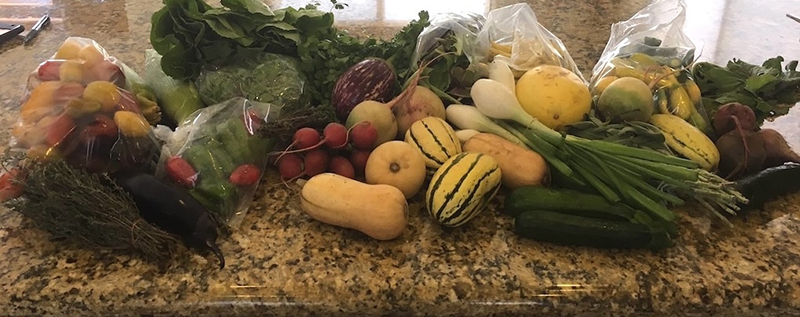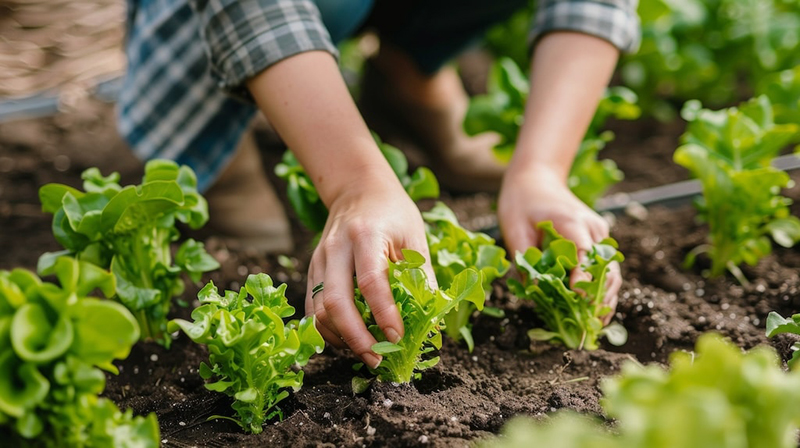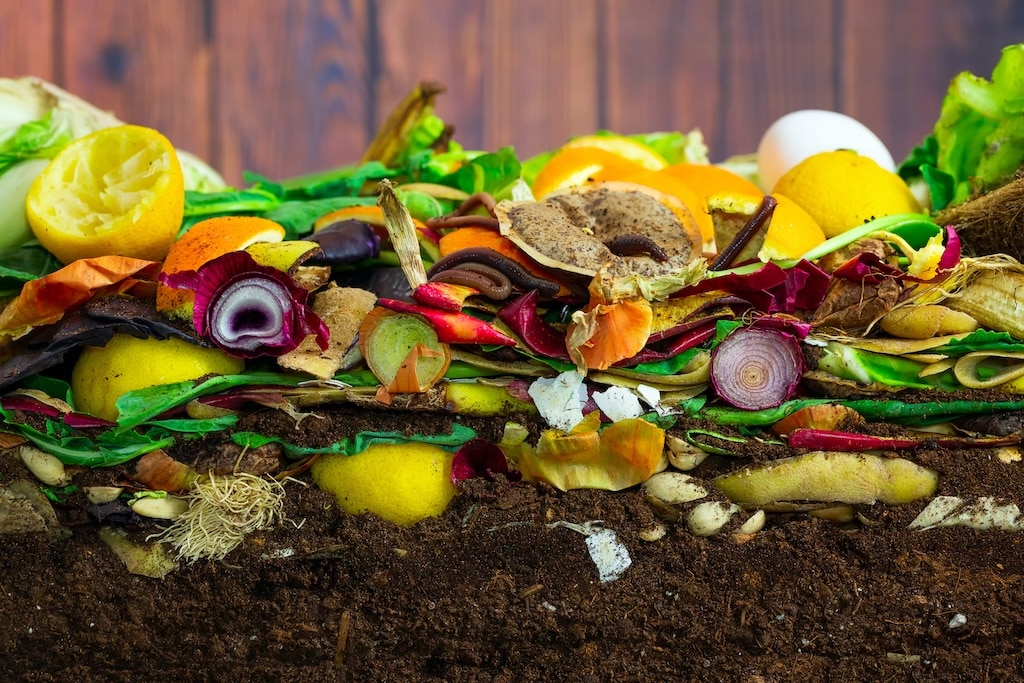Growing your own produce in Baja requires a few adjustments. Here are a few tips to get you started.
By Sue Bell
An abundance of fresh, locally grown produce is one of the many delights newcomers learn to appreciate when they visit or make the move to La Paz, BCS, Mexico. While excellent local produce is often readily available and inexpensive here, growing your own vegetable or herb garden in La Paz can be an even more rewarding experience. Gardening also provides a routine and structure that can be important to those adjusting to retirement, and has the added benefit of paying you back with healthy and tasty produce to help keep grocery budgets down and good food on the table.

You can grow your own produce in La Paz by adjusting your gardening approach to account for our desert climate.
For those of us from the United States and Canada, gardening in Mexico requires a bit of adjustment from our usual routines and expectations. There are significant differences in soil composition, seasonal conditions such as access to water, duration of sunlight, temperatures and intensity of the sun, to name just a few factors. You may also encounter differences in access to seeds, fertilizers, and other necessities you may be used to, and even what mulching looks like in Mexico compared to up north. However, with a little research, patience and persistence, gardening in La Paz can be VERY enjoyable and hugely rewarding.
First, let´s talk about soil
Mexico is a huge country with a great deal of variance in the geography and the climate from one region to the next, and each one has its own challenges and idiosyncrasies. In La Paz, BCS, the soil tends to be very sandy, which means that it doesn´t hold a lot of moisture and has very little in the way of natural nutrients. While the native trees and plants seem to grow well in these soil conditions, fruits and vegetables that are not native to this region require the gardener do some soil augmentation to create appropriate growing conditions. It is recommended that you dig up the top 18 inches or so of native soil and mix the sandy soil well with humus and compost to create a nutrient-rich, well-draining soil that will support growth for your intended produce.

Mulch your plants to keep them protected from Baja’s heat and sun.
Local residents in La Paz often like to rake their gravel and soil. While this makes your landscape look neat and attractive, it is not healthy for plants in this climate. Instead, you should mulch the plants to keep them protected from the heat and sun. If you have a Mexican gardener, make sure they know that you do not want all of the leaf debris removed, rather it should be piled up around the bases of the plants as part of the mulch.
Seasonal resident and avid gardener, Kat West, has created a great video about gardening in La Paz, in which she talks about what has worked for her and the challenges she has faced in her own garden. Click on the video below to watch it:
Humus, what is it and where can I get it?
Humus is a naturally occurring, nutrient and nitrogen-rich material that provides the necessary nourishment your seeds and seedlings need to grow. It occurs naturally when leaves and plant debris fall to the ground and are exposed to sun and rain. As the material decomposes, humus is created. Unfortunately, many people will remove grass clippings, dried plant parts, and leaf litter instead of leaving them in place to decay and turn into humus. If you have access to these kinds of materials, save them to help create good quality humus for your garden. If you don’t have access to what you need, we are fortunate to have sources of humus for purchase in La Paz. For example, check out Tienda del Jardín on Legaspe ( https://www.facebook.com/TiendadelJardin/). Big box stores, such as Home Depot, sell bags of potting mix, but you need to be very careful about buying bagged “potting soil”, especially cheap ones, since different plants and locations need different potting soil recipes, and the ingredients in the soil matter. Check out the article on Potting Soils in the references section below for more information.
Peat moss is another ingredient that many people add to their gardens to help provide nutrients and drainage. It is partially decayed plant material. While it is a component of humus, it may require additional augmentation materials to create nutrient rich soil.

When you compost your own organic materials, the result is man-made humus, which helps plants thrive.
What is compost and how is it different from humus?
When you compost your organic materials, the result is man-made humus. It can take 12-14 weeks, depending on which materials are used, the temperature and moisture levels, as well as how much turning of the pile is done during the process. Eventually, the materials will decompose and create usable humus.
Seasonal conditions/climate
Temperature and Light
In most of the United States and Canada, the winter season from November to March tends to be much colder and to have shorter days, and hence fewer hours of sunlight. The growing season up north typically starts when the days begin getting longer and warmer, sometime in the spring (March/April/May) and finishes in the fall (September/October/November) before the first frost. However, in La Paz, the heat and the intensity of the sun is just too much for gardens between May and September. Luckily, being so close to the Tropic of Cancer, there is not a huge difference in the length of the day between the longest and shortest days of the year here in La Paz, so we are able to grow our gardens through what would be considered winter here, when the sun is not so intense. The growing season here starts in late September and goes until the end of April.

The growing season in LaPaz starts in November and goes through the end of April. The summer months are often too hot to grow vegetables here.
Water Considerations
La Paz, and the whole of Baja California Sur, is a desert climate. That means there is very limited access to water. For this reason, it is best to grow plants during the cooler months. Choose plants that need less water, and employ automatic watering systems if at all possible. There are several companies in La Paz that sell the materials necessary to create an automatic watering system, see the references below for suggestions. Also check out Kat West’s YouTube video above, where she talks about Rachio, an automatic watering system app that allows the user to control and manage their automatic watering system remotely with ease.
What to grow

As with any climate, there are some plants that grow better in La Paz’s dry, desert climate. Following are some suggestions for plants that grow well in the winter in La Paz, so long as you augment the soil and provide appropriate water. The list is not exhaustive, but will give you a good starting point.
Herbs that grow well in La Paz: Dill, Basil (grows really well and can ´over summer´), Oregano, Cilantro, Rosemary, Mint, Spearmint, Onions, Spring onions
Veggies that grow well in La Paz: Lettuces (grow well and can self-seed), Tomatoes, Arugula, Cucumbers, Corn, Beans, Peppers (bell and spicy)
Fruits that grow in La Paz: Passion Fruit, Figs, Oranges, Tangerines, Pomegranates, Limes, Key-Limes, Avocado (needs lots of water and space), Mango (needs lots of water and space), Grapefruits, Desert Plum
Some other plants that grow well here include: Pistachio, Tamarindo, Coconut Palms, and Papaya, but some of these Items can be finicky.
Challenges to gardening in La Paz
Of course, in addition to the soil and water issues, there are some other important challenges to growing a garden in a desert climate. First, finding seeds in Mexico can be difficult. The Home Depot does carry some seeds during some seasons, but the choice is limited. Tienda del Jardin also carries seeds. Saving seeds from produce can also be a source of seeds for some plants. I have a friend who has even been able to start her tomatoes by just dropping a tomato that is past its prime into the soil.
Managing critters in order to protect your plants can be a big job. The water and/or irrigation attracts pocket gophers, which eat the roots underground. You may not even know there is a problem until it is too late. Kat West has suggested getting around this by planting seedlings in cages of chicken wire.

Placing chicken wire cages over the seedlings until they are large enough to survive helps to protect them from birds and pocket gophers.
Above ground, birds can be another challenge. They like to pick off the sweet and juicy seedlings just as they are coming up. Placing chicken wire cages over the seedlings until they are large enough to survive really works well.
What to do with all that produce?
Once you begin growing your garden, you’ll soon find you have more produce than you can use! Not to worry, there are several ways you can share and enjoy your bounty:

- Trade with other gardening minded neighbors who are growing things you are not.
- Join a local gardening Facebook group like these to exchange ideas:
- Ask local La Paz and El Centenario area farmer’s markets if you can join and sell your produce.
- Invest in a Baja cookbook like this one to make the most of that wonderful produce!
- Join a cooking class to learn how to make local cuisine with your fresh vegetables and herbs.
When all is said and done, gardening is a great pastime that can be very rewarding. If you do your research, practice patience and persistence you can enjoy a productive garden here in the Baja.
Resources
- Tienda del Jardín: https://www.facebook.com/TiendadelJardin/ – Calle Legaspe between Prieto and Serdan – A small, organic products shop that also sells many of the necessities for home gardening including: seeds, soil augmentation products such as humus and compost as well as tools and equipment for watering, etc.
- Landscaping Dos and Don’ts: Desert Edition at https://lapaz.pedregal.com/landscaping-dos-and-donts-desert-edition/
- Gardening Secrets Revealed: Maximize your harvest in Mexico’s Baja https://www.youtube.com/watch?v=LbuClAHRmnQ
- The Secret to Good Potting Soil: https://laidbackgardener.blog/2024/02/03/the-secret-to-good-potting-soil/
- Composting Process and Techniques: https://www.fao.org/3/y5104e/y5104e05.htm#:~:text=In%20this%20process%2C%20aerobic%20microorganisms,relatively%20stable%20organic%20end%20product

Sue is Baja Life Realty’s office and marketing administrator, helping us out with a variety of projects, including Spanish translations of key documents, keeping our listings up to date, and promoting the La Paz lifestyle on our Facebook page and blog. In addition to her work at Baja Life Realty, Sue is a bilingual personal concierge. That means she helps clients with setting up services such as banking, utilities, cell phone service and more. She hosts a Starter Kit for Living in Baja workshop, which teaches new homeowners how to connect with local contractors, join local expat groups, source furniture and other items for your home, and much more. To learn more about Sue’s personal concierge service, watch her video.

